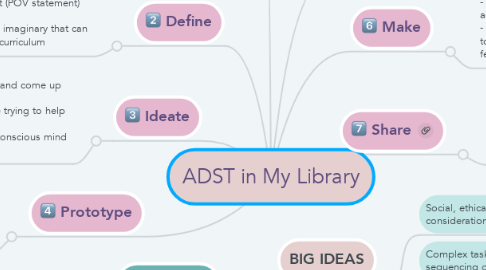ADST in My Library
by Victoria Maciver

1. Prototype
1.1. - Ask yourself: How does your idea fit in the context of peoples actual lives? - Provide a model for the solution - Can be scale representations or symbolic representations
2. Ideate
2.1. - Focus on the problem statement and come up with many solutions, not just one. - Show them to the people you are trying to help and get feedback - Combine your conscious and unconscious mind Brainstorming and mind maps
3. Define
3.1. - Come up with a problem statement (POV statement) - Determine the real problem - Focus on design challenge that are imaginary that can easily work with the grade level and curriculum
4. Empathy
4.1. - Conduct interviews - Get to know those who are experiencing the problem you are trying to solve - Observe, engage, watch and listen - Allows students to see the “human” side of a problem making is more relatable
5. Yes, and...?
5.1. Build on others ideas
6. Share
6.1. - A presentation of the end product, could be done for the class or for a bigger community of people
7. Make
7.1. - Final products could be advertising posters or a website - Students will have made changes to based off of the testing and feedback
8. Test
8.1. - Find out what worked and what didn’t - Receive feedback - No bias or defending your prototype, just receiving the feedback from users
9. BIG IDEAS
9.1. Social, ethical, and sustainability considerations impact design.
9.2. Complex tasks require the sequencing of skills.
9.3. Complex tasks require different technologies and tools at different stages.
10. Grade 10, 11, 12


